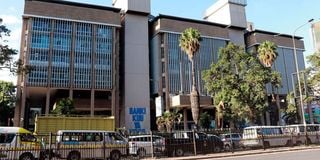Costly loans loom as inter bank rate at 38-month high

Central Bank of Kenya headquarters in Nairobi. The cost of lending between banks has hit a high of 38 months, signaling a fresh surge in loan prices amid tightened cash supply in the banking system.
The cost of lending between banks has hit a high of 38 months, signaling a fresh surge in loan prices amid tightened cash supply in the banking system.
The inter-bank rate shot up to 6.76 per cent on Friday, data by the Central Bank of Kenya (CBK) showed --the highest level since December 10, 2019, when it stood at 6.77 per cent.
The inter-bank rate is the interest charged on short-term loans between them. Banks borrow and lend money in the interbank lending market to manage liquidity and satisfy regulations such as reserve requirements.
Regulations demand that banks hold an adequate level of liquid assets, such as cash, to manage any potential bank runs by clients. If a bank cannot meet these liquidity requirements, it will need to borrow money in the interbank market to cover the shortfall.
Some lenders, on the other hand, have excess liquid assets above and beyond the regulatory requirements. These banks will lend money in the interbank market, receiving interest on the assets.
The interest rate charged depends on availability of money in the market, on prevailing rates, and the specific terms of the contract, such as term length. Interbank borrowing does not require collateral security and is based on a bank’s assessment of the risk of lending to peers. The latest surge in inter-bank lending rates points to fresh pressure on bank loan charges that have been on a rise in the past months on tightened liquidity. The cost of bank loans hit a 52-month high in December in the wake of the CBK rate hikes and rising yields on government paper.
The average lending rate rose to 12.67 per cent in December— the highest average lending rate since August 2018 when it stood at 12.78 per cent.
Agitated by tightening liquidity, commercial banks have raised interest rates on savings and deposits to pre-pandemic levels in a bid to lock in wealthy savers who have an option of moving their cash to higher-yielding Treasuries and money-market funds.
The rates on savings accounts have been rising to the three percent mark in the three months to October, a sign that lenders are under pressure to mop up money for onward lending.
The rate hit 3.47 per cent last August, the highest level since 3.48 per cent in March 2021 and from 2.94 per cent in the previous month, but slowed down to 3.44 per cent last September.
The rate is payable to checking accounts, which allow depositors to add funds, withdraw and transfer occasionally unlike the fixed deposit accounts, which have higher and attractive interest rates and are preferred by individual savers for long-term investments.





